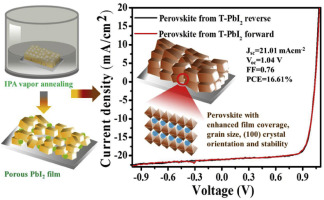Organic Electronics ( IF 2.7 ) Pub Date : 2017-10-31 , DOI: 10.1016/j.orgel.2017.10.037 Qiuju Liang , Jie Han , Hongxiang Li , Liang Chen , Zhiyuan Xie , Jiangang Liu , Yanchun Han

|
The photovoltaic performance and stability of perovskite solar cells (PVSCs) is deeply dependent on the morphology of the perovskite film and the amount of lead iodide (PbI2) residue. However, the morphology of perovskite film fabricated through two-step sequential deposition method usually suffers from poor film coverage and low crystallinity due to the ungovernable crystallization kinetics. Moreover, owing to the compact stacking of PbI2 crystals, the conversion of PbI2 is incomplete as well. In this work, we propose for the first time to control the nanostructure of PbI2 to get high crystallinity, identical (100) crystal orientation and PbI2 residue-free film. Porous PbI2 with plate structure was obtained by selected solvent annealing (SSA). The reaction rate between PbI2 and methylammonium iodide (MAI) was accelerated because the contact area between PbI2 and MAI was enlarged due to the porous nanostructure of PbI2. Thus, uniform, high crystalline perovskite film without PbI2 residue was obtained. Furthermore, (100) crystal orientation of perovskite was obtained due to the PbI2 shape changing from grain to plate, which originated from the changing growth frontier of PbI2 crystals. As a result, a promising power conversion efficiency of 16.61% is achieved in planar-heterojunction PVSCs due to improved photoabsorption and carrier extraction efficiency. This work for the first time establishes the relationship between PbI2 structure and the corresponding structure of perovskite in detail, and shows a reasonable design of PbI2 nanostructure is important to improve the perovskite morphology.
中文翻译:

通过控制PbI 2的纳米结构,均匀,高结晶,(100)晶体取向的钙钛矿薄膜而无PbI 2残留
钙钛矿太阳能电池(PVSCs)的光伏性能和稳定性在很大程度上取决于钙钛矿薄膜的形态和碘化铅(PbI 2)残留量。然而,由于不可控制的结晶动力学,通过两步顺序沉积法制备的钙钛矿膜的形态通常遭受差的膜覆盖率和低结晶度的困扰。此外,由于碘化铅的紧凑堆叠2晶体,PBI的转化2是不完全的,以及。在这项工作中,我们首次建议控制PbI 2的纳米结构以获得高结晶度,相同的(100)晶体取向和无PbI 2残留的薄膜。多孔PbI 2通过选择溶剂退火(SSA)获得具有板状结构的材料。碘化铅之间的反应速率2和甲基铵碘化物(MAI)被加速,因为碘化铅之间的接触面积2和MAI是由于放大到碘化铅的多孔纳米结构2。因此,获得了没有PbI 2残留物的均匀的高结晶钙钛矿膜。另外,是由于得到的碘化铅(100)的钙钛矿的晶体取向2形状改变从谷物至板,它源于碘化铅的改变生长前沿2晶体。结果,由于改善了光吸收和载流子提取效率,在平面异质结PVSC中实现了有希望的16.61%的功率转换效率。这项工作首次详细建立了PbI 2结构与钙钛矿相应结构之间的关系,并显示出合理的PbI 2纳米结构设计对于改善钙钛矿的形态非常重要。











































 京公网安备 11010802027423号
京公网安备 11010802027423号